steering RENAULT TWINGO RS 2009 2.G Engine Diesel Injection Workshop Manual
[x] Cancel search | Manufacturer: RENAULT, Model Year: 2009, Model line: TWINGO RS, Model: RENAULT TWINGO RS 2009 2.GPages: 269
Page 8 of 269

13B-8V6 MR-413-X44-13B000$020.mif
13B
DCM 1.2 Injection
Program No.: 4D
Vdiag No.: 48, 4C, 50,
54, 58, 5C
I. HAZARDS ASSOCIATED WITH CONTAMINATION
The high pressure direct injection system is highly sensitive to contamination. The risks associated with
contamination are:
–damage to or destruction of the high pressure injection system,
–components jamming,
–components losing seal integrity.
All After-Sales operations must be performed under very clean conditions. This means that no impurities
(particles a few microns in size) should have entered the system during dismantling.
The cleanliness principle must be applied from the filter to the injectors.
What are the sources of contamination?
–metal or plastic swarf,
–paint,
–fibres: from cardboard,
from brushes,
from paper,
from clothing,
from cloths.
–foreign bodies such as hair,
–ambient air
–etc.
II. ADVICE TO BE FOLLOWED BEFORE ANY OPERATION
Check that you have plugs for the unions to be opened (set of plugs available from the Parts Department). The plugs
are single-use only. After use, they must be discarded (once used they are soiled and cleaning is not sufficient to
make them reusable). Unused plugs must also be discarded.
Check that you have hermetically resealable plastic bags for storing removed parts. Parts stored in this way will be
less susceptible to the risk of contamination. The bags are single-use only. Once used, they must be thrown out.
Use lint-free cleaning cloths (cloth part reference 77 11 211 707). Using normal cloth or paper is prohibited. They are
not lint-free and could contaminate the fuel circuit. Each cloth should only be used once.
Use fresh cleaning agent for each operation (used cleaning agent is contaminated). Pour it into an uncontaminated
container.
For each operation, use a clean brush in good condition (the brush must not shed its bristles).
Use a brush and cleaning agent to clean the unions to be opened.IMPORTANT
Cleaning the engine using a high pressure washer is prohibited because of the risk of damaging connections. In
addition, moisture may collect in the connectors and create electrical connection faults.
IMPORTANT
Before any work is carried out on the high pressure injection system, protect:
–the accessories and timing belts,
–the electrical accessories, (starter, alternator, electric power-assisted steering pump),
–the flywheel surface, to prevent any diesel from running onto the clutch friction plate.
DIESEL INJECTION
Fault finding – Cleanliness guidelines
Page 10 of 269
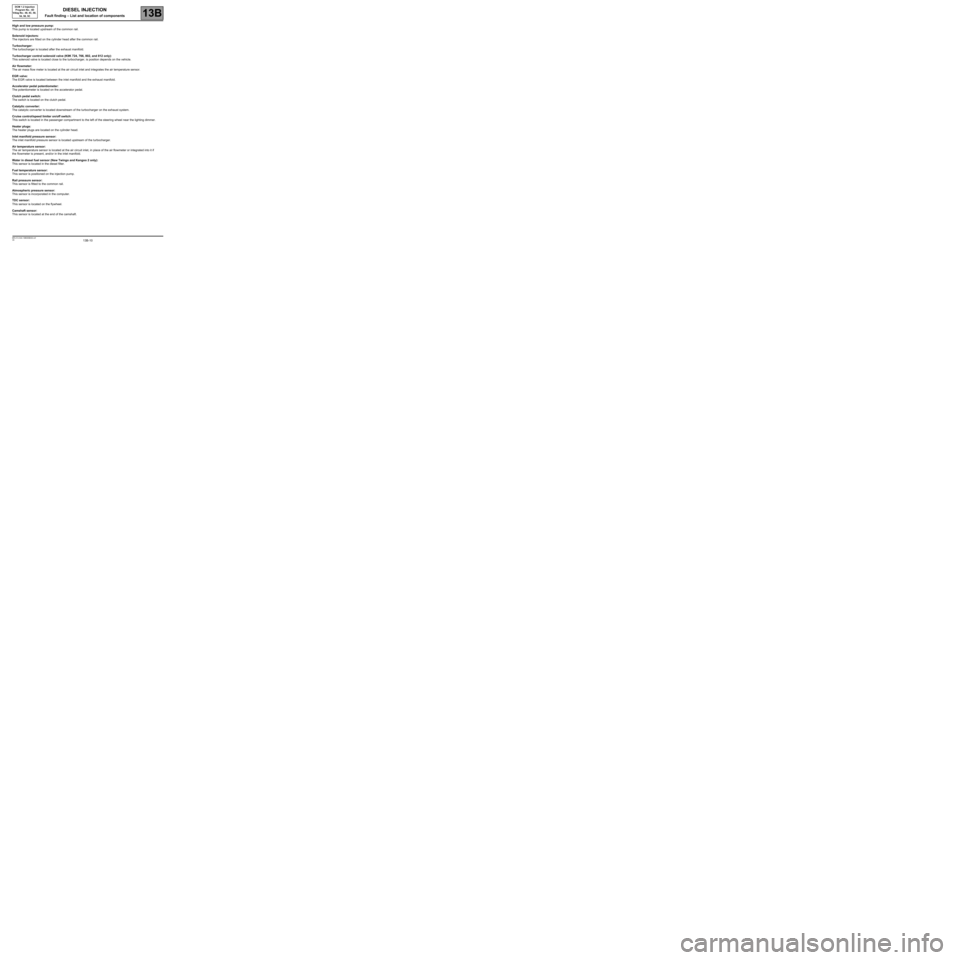
13B-10V6 MR-413-X44-13B000$030.mif
13B
DCM 1.2 Injection
Program No.: 4D
Vdiag No.: 48, 4C, 50,
54, 58, 5C
High and low pressure pump:
This pump is located upstream of the common rail.
Solenoid injectors:
The injectors are fitted on the cylinder head after the common rail.
Turbocharger:
The turbocharger is located after the exhaust manifold.
Turbocharger control solenoid valve (K9K 724, 766, 802, and 812 only):
This solenoid valve is located close to the turbocharger, is position depends on the vehicle.
Air flowmeter:
The air mass flow meter is located at the air circuit inlet and integrates the air temperature sensor.
EGR valve:
The EGR valve is located between the inlet manifold and the exhaust manifold.
Accelerator pedal potentiometer:
The potentiometer is located on the accelerator pedal.
Clutch pedal switch:
The switch is located on the clutch pedal.
Catalytic converter:
The catalytic converter is located downstream of the turbocharger on the exhaust system.
Cruise control/speed limiter on/off switch:
This switch is located in the passenger compartment to the left of the steering wheel near the lighting dimmer.
Heater plugs:
The heater plugs are located on the cylinder head.
Inlet manifold pressure sensor:
The inlet manifold pressure sensor is located upstream of the turbocharger.
Air temperature sensor:
The air temperature sensor is located at the air circuit inlet, in place of the air flowmeter or integrated into it if
the flowmeter is present, and/or in the inlet manifold.
Water in diesel fuel sensor (New Twingo and Kangoo 2 only):
This sensor is located in the diesel filter.
Fuel temperature sensor:
This sensor is positioned on the injection pump.
Rail pressure sensor:
This sensor is fitted to the common rail.
Atmospheric pressure sensor:
This sensor is incorporated in the computer.
TDC sensor:
This sensor is located on the flywheel.
Camshaft sensor:
This sensor is located at the end of the camshaft.
DIESEL INJECTION
Fault finding – List and location of components
Page 18 of 269
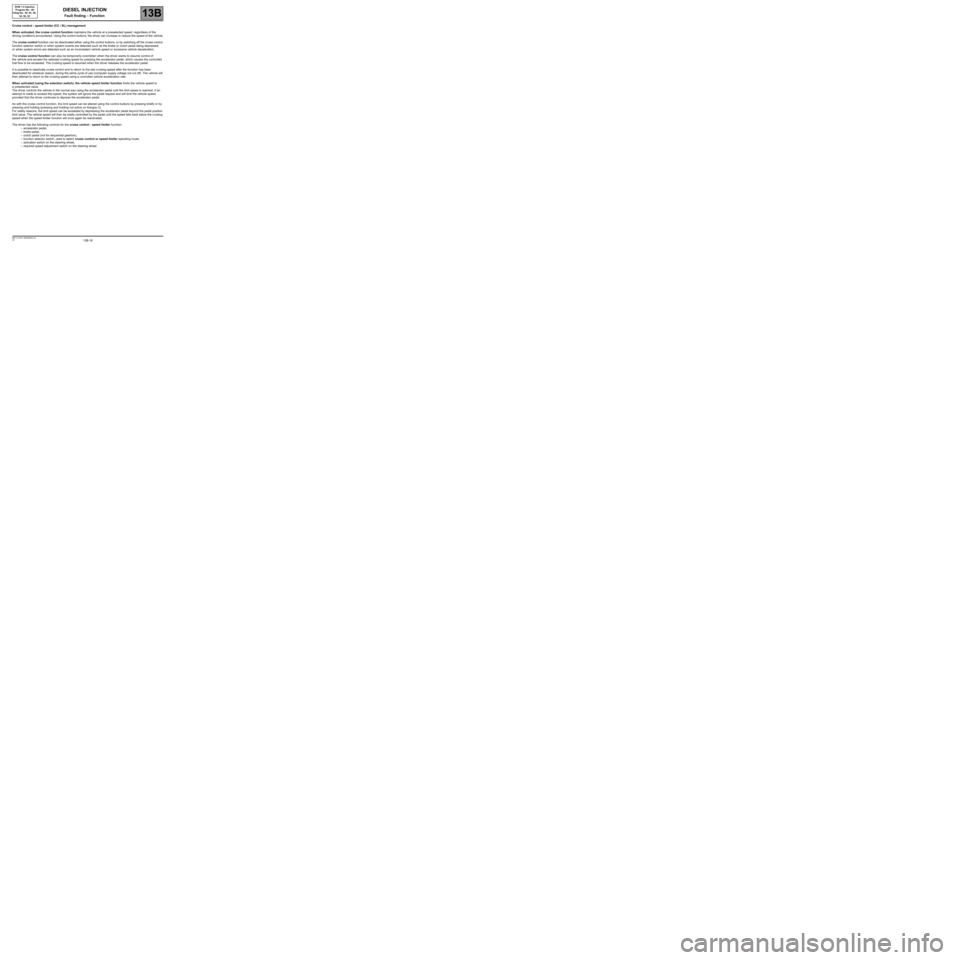
13B-18V6 MR-413-X44-13B000$040.mif
DIESEL INJECTION
Fault finding – Function13B
DCM 1.2 Injection
Program No.: 4D
Vdiag No.: 48, 4C, 50,
54, 58, 5C
Cruise control - speed limiter (CC / SL) management
When activated, the cruise control function maintains the vehicle at a preselected speed, regardless of the
driving conditions encountered. Using the control buttons, the driver can increase or reduce the speed of the vehicle.
The cruise control function can be deactivated either using the control buttons, or by switching off the cruise control
function selector switch or when system events are detected such as the brake or clutch pedal being depressed,
or when system errors are detected such as an inconsistent vehicle speed or excessive vehicle deceleration.
The cruise control function can also be temporarily overridden when the driver wants to resume control of
the vehicle and exceed the selected cruising speed by pressing the accelerator pedal, which causes the controlled
fuel flow to be exceeded. The cruising speed is resumed when the driver releases the accelerator pedal.
It is possible to reactivate cruise control and to return to the last cruising speed after the function has been
deactivated for whatever reason, during the same cycle of use (computer supply voltage not cut off). The vehicle will
then attempt to return to the cruising speed using a controlled vehicle acceleration rate.
When activated (using the selection switch), the vehicle speed limiter function limits the vehicle speed to
a preselected value.
The driver controls the vehicle in the normal way using the accelerator pedal until the limit speed is reached. If an
attempt is made to exceed this speed, the system will ignore the pedal request and will limit the vehicle speed,
provided that the driver continues to depress the accelerator pedal.
As with the cruise control function, the limit speed can be altered using the control buttons by pressing briefly or by
pressing and holding (pressing and holding not active on Kangoo 2).
For safety reasons, the limit speed can be exceeded by depressing the accelerator pedal beyond the pedal position
limit value. The vehicle speed will then be totally controlled by the pedal until the speed falls back below the cruising
speed when the speed limiter function will once again be reactivated.
The driver has the following controls for the cruise control - speed limiter function:
–accelerator pedal,
–brake pedal,
–clutch pedal (not for sequential gearbox),
–function selector switch, used to select cruise control or speed limiter operating mode,
–activation switch on the steering wheel,
–required speed adjustment switch on the steering wheel.
Page 114 of 269

13B-114
AFTER REPAIRDeal with any faults displayed by the diagnostic tool.
Clear the computer fault memory.
Carry out a road test followed by another check with the diagnostic tool.
V6 MR-413-X44-13B000$120.mif
DIESEL INJECTION
Fault finding – Interpretation of faults13B
DCM 1.2 Injection
Program No.: 4D
Vdiag No.: 48, 4C, 50
DF242
PRESENT OR
STOREDENGINE SPEED SIGNAL OUTPUTCC.1: Short circuit to + 12 volts
CO.0: Open circuit or short circuit to earth
NOTESSpecial note:
The operation of the power-assisted steering is not correct.
See Technical Note Wiring Diagrams of the vehicle concerned
Check the connection and condition of the variable power-assisted steering connector, component code 502.
Check the connection and condition of connector B (brown 48-track) of the injection computer, component
code 120.
If the connector(s) is faulty and if there is a repair procedure (see Technical Note 6015A, Repairing electrical
wiring, Wiring: Precautions for repair), repair the connector, otherwise replace the wiring.
Check the insulation and continuity of the following connection:
–H7 between components 120 and 502.
If the connection is faulty and there is a repair procedure (see Technical Note 6015A, Electrical wiring repair,
Wiring: Precautions for repair), repair the wiring, otherwise replace it.
If the fault is still present, run fault finding on the power-assisted steering and the sequential gearbox (see 36B,
Power-assisted steering) and (see 21B, Sequential gearbox).
If the fault is still present, contact the Techline.
DCM1.2_V48_DF242/DCM1.2_V4C_DF242/DCM1.2_V50_DF242
Page 156 of 269
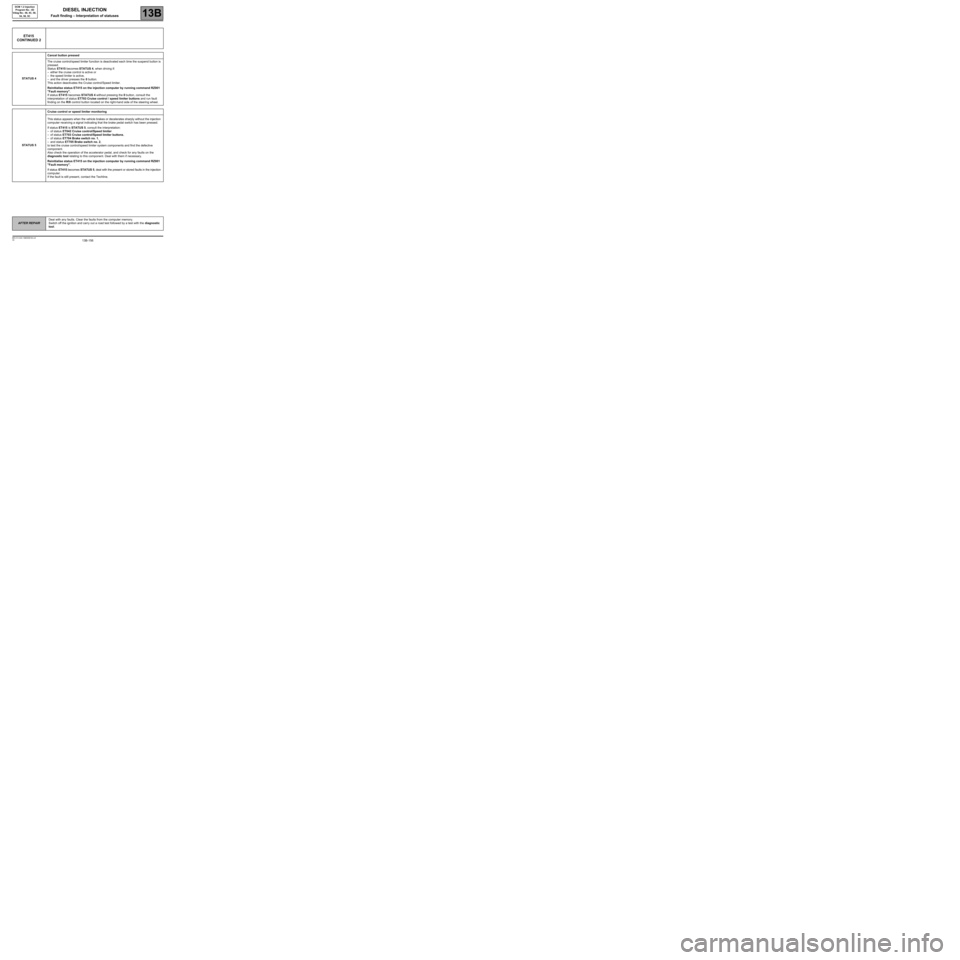
13B-156
AFTER REPAIRDeal with any faults. Clear the faults from the computer memory.
Switch off the ignition and carry out a road test followed by a test with the diagnostic
tool.
V6 MR-413-X44-13B000$150.mif
DIESEL INJECTION
Fault finding – Interpretation of statuses13B
DCM 1.2 Injection
Program No.: 4D
Vdiag No.: 48, 4C, 50,
54, 58, 5C
ET415
CONTINUED 2
STATUS 4Cancel button pressed
The cruise control/speed limiter function is deactivated each time the suspend button is
pressed.
Status ET415 becomes STATUS 4, when driving if:
–either the cruise control is active or
–the speed limiter is active,
–and the driver presses the 0 button.
This action deactivates the Cruise control/Speed limiter.
Reinitialise status ET415 on the injection computer by running command RZ001
"Fault memory".
If status ET415 becomes STATUS 4 without pressing the 0 button, consult the
interpretation of status ET703 Cruise control / speed limiter buttons and run fault
finding on the R/0 control button located on the right-hand side of the steering wheel.
STATUS 5Cruise control or speed limiter monitoring
This status appears when the vehicle brakes or decelerates sharply without the injection
computer receiving a signal indicating that the brake pedal switch has been pressed.
If status ET415 is STATUS 5, consult the interpretation:
–of status ET042 Cruise control/Speed limiter
–of status ET703 Cruise control/Speed limiter buttons,
–of status ET704 Brake switch no. 1,
–and status ET705 Brake switch no. 2,
to test the cruise control/speed limiter system components and find the defective
component.
Also check the operation of the accelerator pedal, and check for any faults on the
diagnostic tool relating to this component. Deal with them if necessary.
Reinitialise status ET415 on the injection computer by running command RZ001
"Fault memory".
If status ET415 becomes STATUS 5, deal with the present or stored faults in the injection
computer.
If the fault is still present, contact the Techline.
Page 162 of 269
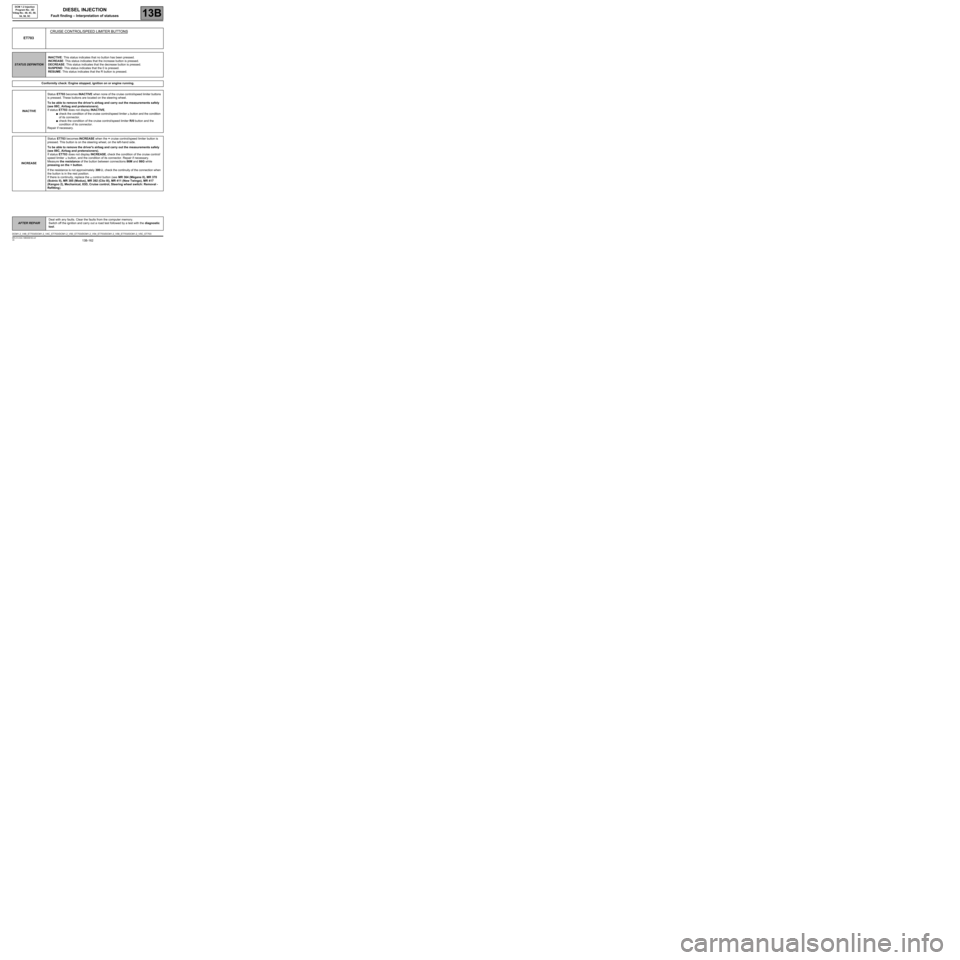
13B-162
AFTER REPAIRDeal with any faults. Clear the faults from the computer memory.
Switch off the ignition and carry out a road test followed by a test with the diagnostic
tool.
V6 MR-413-X44-13B000$150.mif
DIESEL INJECTION
Fault finding – Interpretation of statuses13B
DCM 1.2 Injection
Program No.: 4D
Vdiag No.: 48, 4C, 50,
54, 58, 5C
ET703CRUISE CONTROL/SPEED LIMITER BUTTONS
STATUS DEFINITIONINACTIVE: This status indicates that no button has been pressed.
INCREASE: This status indicates that the increase button is pressed.
DECREASE: This status indicates that the decrease button is pressed.
SUSPEND: This status indicates that the 0 is pressed.
RESUME: This status indicates that the R button is pressed.
Conformity check: Engine stopped, ignition on or engine running.
INACTIVEStatus ET703 becomes INACTIVE when none of the cruise control/speed limiter buttons
is pressed. These buttons are located on the steering wheel.
To be able to remove the driver's airbag and carry out the measurements safely
(see 88C, Airbag and pretensioners).
If status ET703 does not display INACTIVE,
●check the condition of the cruise control/speed limiter ± button and the condition
of its connector.
●check the condition of the cruise control/speed limiter R/0 button and the
condition of its connector.
Repair if necessary.
INCREASEStatus ET703 becomes INCREASE when the + cruise control/speed limiter button is
pressed. This button is on the steering wheel, on the left-hand side.
To be able to remove the driver's airbag and carry out the measurements safely
(see 88C, Airbag and pretensioners).
If status ET703 does not display INCREASE, check the condition of the cruise control/
speed limiter
± button, and the condition of its connector. Repair if necessary.
Measure the resistance of the button between connections 86M and 86G while
pressing on the + button.
If the resistance is not approximately 300 Ω, check the continuity of the connection when
the button is in the rest position.
If there is continuity, replace the
± control button (see MR 364 (Mégane II), MR 370
(Scénic II), MR 385 (Modus), MR 392 (Clio III), MR 411 (New Twingo), MR 417
(Kangoo 2), Mechanical, 83D, Cruise control, Steering wheel switch: Removal -
Refitting).
DCM1.2_V48_ET703/DCM1.2_V4C_ET703/DCM1.2_V50_ET703/DCM1.2_V54_ET703/DCM1.2_V58_ET703/DCM1.2_V5C_ET703
Page 163 of 269
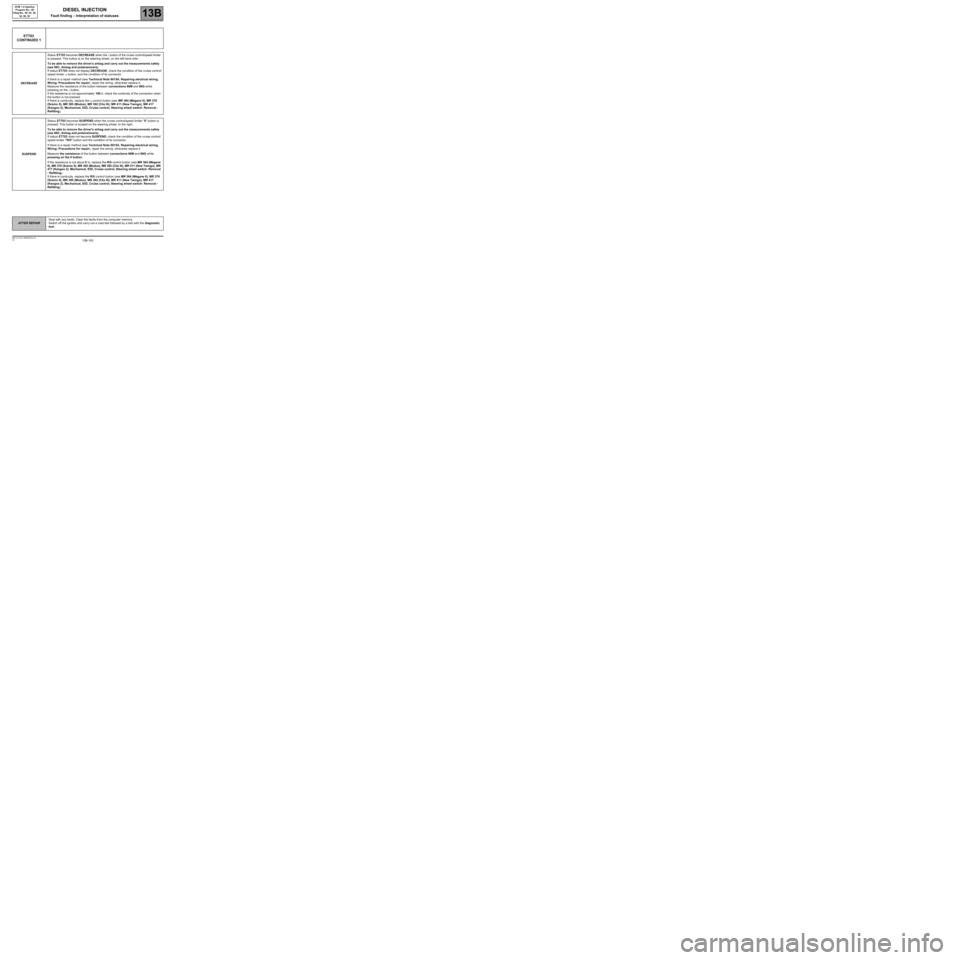
13B-163
AFTER REPAIRDeal with any faults. Clear the faults from the computer memory.
Switch off the ignition and carry out a road test followed by a test with the diagnostic
tool.
V6 MR-413-X44-13B000$150.mif
DIESEL INJECTION
Fault finding – Interpretation of statuses13B
DCM 1.2 Injection
Program No.: 4D
Vdiag No.: 48, 4C, 50,
54, 58, 5C
ET703
CONTINUED 1
DECREASEStatus ET703 becomes DECREASE when the - button of the cruise control/speed limiter
is pressed. This button is on the steering wheel, on the left-hand side.
To be able to remove the driver's airbag and carry out the measurements safely
(see 88C, Airbag and pretensioners).
If status ET703 does not display DECREASE, check the condition of the cruise control/
speed limiter
± button, and the condition of its connector.
If there is a repair method (see Technical Note 6015A, Repairing electrical wiring,
Wiring: Precautions for repair), repair the wiring, otherwise replace it.
Measure the resistance of the button between connections 86M and 86G while
pressing on the - button.
If the resistance is not approximately 100 Ω, check the continuity of the connection when
the button is not pressed.
If there is continuity, replace the
± control button (see MR 364 (Mégane II), MR 370
(Scénic II), MR 385 (Modus), MR 392 (Clio III), MR 411 (New Twingo), MR 417
(Kangoo 2), Mechanical, 83D, Cruise control, Steering wheel switch: Removal -
Refitting).
SUSPENDStatus ET703 becomes SUSPEND when the cruise control/speed limiter "0" button is
pressed. This button is located on the steering wheel, to the right.
To be able to remove the driver's airbag and carry out the measurements safely
(see 88C, Airbag and pretensioners).
If status ET703 does not become SUSPEND, check the condition of the cruise control/
speed limiter "R/0" button and the condition of its connector.
If there is a repair method (see Technical Note 6015A, Repairing electrical wiring,
Wiring: Precautions for repair), repair the wiring, otherwise replace it.
Measure the resistance of the button between connections 86M and 86G while
pressing on the 0 button.
If the resistance is not about 0 Ω, replace the R/0 control button (see MR 364 (Mégane
II), MR 370 (Scénic II), MR 385 (Modus), MR 392 (Clio III), MR 411 (New Twingo), MR
417 (Kangoo 2), Mechanical, 83D, Cruise control, Steering wheel switch: Removal
- Refitting).
If there is continuity, replace the R/0 control button (see MR 364 (Mégane II), MR 370
(Scénic II), MR 385 (Modus), MR 392 (Clio III), MR 411 (New Twingo), MR 417
(Kangoo 2), Mechanical, 83D, Cruise control, Steering wheel switch: Removal -
Refitting).
Page 164 of 269

13B-164
AFTER REPAIRDeal with any faults. Clear the faults from the computer memory.
Switch off the ignition and carry out a road test followed by a test with the diagnostic
tool.
V6 MR-413-X44-13B000$150.mif
DIESEL INJECTION
Fault finding – Interpretation of statuses13B
DCM 1.2 Injection
Program No.: 4D
Vdiag No.: 48, 4C, 50,
54, 58, 5C
ET703
CONTINUED 2
RESUMEStatus ET703 becomes RESUME when the cruise control/speed limiter "R" button is
pressed. This button is located on the steering wheel, to the right.
To be able to remove the driver's airbag and carry out the measurements safely
(see 88C, Airbag and pretensioners).
If status ET703 does not change to RESUME, check the condition of the cruise control/
speed limiter R/0 button, and the condition of its connector.
If there is a repair method (see Technical Note 6015A, Repairing electrical wiring,
Wiring: Precautions for repair), repair the wiring, otherwise replace it.
Measure the resistance of the button between connections 86M and 86G while
pressing on the R button.
If the resistance is not approximately 900 Ω, check the continuity of the connection when
the button is not pressed.
If there is continuity, replace the R/0 control button (see MR 364 (Mégane II), MR 370
(Scénic II), MR 385 (Modus), MR 392 (Clio III), MR 411 (New Twingo), MR 417
(Kangoo 2), Mechanical, 83D, Cruise control, Steering wheel switch: Removal -
Refitting).